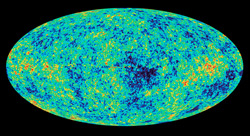Get started with Wolfram technologies, or work with us to apply computational expertise to your projects.
Questions? Comments? Get in touch: 1-800-WOLFRAM, or email us

Physicist, professor, and science columnist John Cramer tells Wolfram Research that he recently used Mathematica to produce a 100-second simulation of the sound of the Big Bang during the first 760,000 years of the evolution of the universe. Cramer, who is on faculty at the University of Washington, reports, "The result sounds rather like a large jet airplane flying over your house at an altitude of 100 feet in the middle of the night."
Marcus Chown, a British science writer with whom Cramer frequently interacts, wrote a story about Cramer's simulation for the November 1 issue of New Scientist. This story "produced an amazing explosion of media attention," says Cramer. "I've been repeatedly interviewed, including three separate BBC interviews for BBC Radio 4, BBC Radio 5, and BBC Foreign Service. A friend in Poland said he heard about my work on a Polish national news broadcast. Among other places, I was in the lead headline in a Turkish newspaper called SABAH, was featured on the Arab news service Al Jazeera, and was in the Shanghai Daily newspaper. Our local web server has crashed repeatedly under the load of people attempting to download the sound file."
Cramer explains, "The story of how I came to produce the sound of the Big Bang goes like this. My principal research area is ultra-relativistic heavy ion physics. I don't work much in cosmology and astrophysics although I've published a paper or two in those areas. However, I also write a bimonthly science column for Analog magazine that often deals with cosmology. One of these columns, entitled 'BOOMERanG and the Sound of the Big Bang,' was published in the January 2001 issue of Analog and is also available on the web. It describes the then-recent Antarctic balloon flight that mapped the small-angle structure of the cosmic background radiation. Following the lead of the scientists involved in the project, I described the temperature variations they observed as, in effect, a recording of the 'sound of the Big Bang' when the universe was 376,000 years old.
"About a month ago, I received an email from a reader. She said that her 11-year-old son was doing a school project on the Big Bang and that they had seen it mentioned in my column on the web. She was wondering if the sound of the Big Bang was actually recorded anywhere so that he could play it for his class. My answer was 'no,' but her interesting question caused me to consider the problem. With the data available from BOOMERanG and more recently from WMAP, it would not be too difficult to simulate the sound using Mathematica, which includes the feature of rendering mathematical functions as sound that can be captured on .wav files.
"The idea of synthesizing the Big Bang sound ran around in my head for several days. I decided that I really needed to hear what the Big Bang sounded like. So, one Saturday morning when I should have been doing something else, I sat down and wrote a 16-line Mathematica program that produces the sound and saved it as a .wav file. I downloaded the frequency spectrum measured by NASA's WMAP satellite site and used it as input data for the program.
"The notebook combines the WMAP measured frequencies, appropriately scaled for the human ear, assuming that all of the sinusoids start at a maximum at t = 0 (the start of the Big Bang). It frequency-shifts them downward as time 2/3 as the universe expands and becomes more of a 'bass instrument.' The simulation lasts 100 seconds, representing the first 760,000 years of evolution of the universe, and varies the sound intensity to match the cosmic microwave--which according to WMAP peaked at 376,000 years and dropped to 36 percent intensity in 110,000 years on each side of the peak. The sound frequencies used in the simulation must be boosted upward by a huge factor (about 1026) to match the response of the human ear because the actual Big Bang frequencies were far too low to be heard by humans (even had there been any around).
"After I produced the .wav file, I sent an email copy to my reader. She reported that her son's science project was a great success."
Cramer's Mathematica notebook, .wav file, and input data for the simulation can be found in "The Sound of the Big Bang" in the Wolfram Information Center. For more information on Cramer and his work, visit his home page.